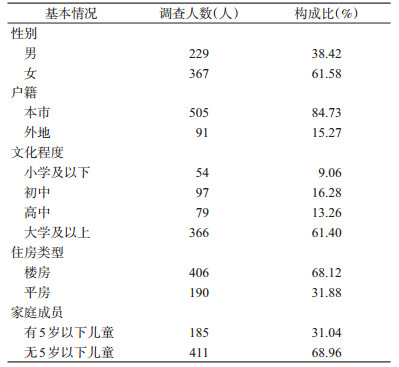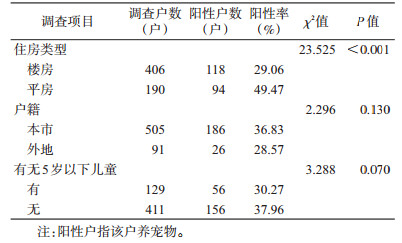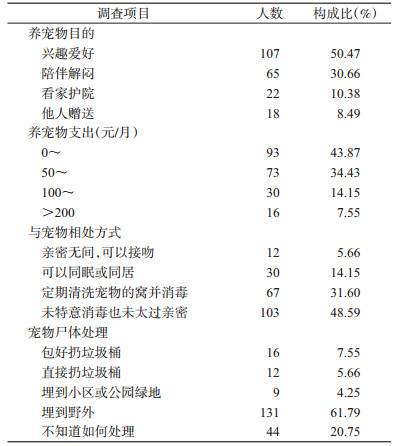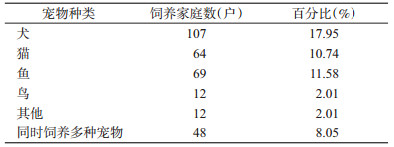
扩展功能
文章信息
- 周冰, 曹殿起, 付慧英, 彭素标, 史文静, 刘缘
- ZHOU Bing, CAO Dian-qi, FU Hui-ying, PENG Su-biao, SHI Wen-jing, LIU Yuan
- 北京市门头沟区常住居民宠物饲养及影响因素现状调查
- An investigation of current pet keeping status of permanent residents in Mentougou district, Beijing, China and the influencing factors
- 中国媒介生物学及控制杂志, 2020, 31(2): 227-230
- Chin J Vector Biol & Control, 2020, 31(2): 227-230
- 10.11853/j.issn.1003.8280.2020.02.023
-
文章历史
- 收稿日期: 2019-10-07
- 网络出版时间: 2020-03-03 17:34
2 北京市东城区疾病预防控制中心, 北京 100050
2 Dongcheng District Center for Disease Control and Prevention of Beijing
宠物受到人类的喜爱,同时伤人事件也屡见不鲜,宠物也是很多人畜共患病的主要传染源[1-5]。为了解门头沟区常住居民宠物饲养现状,为制定宠物相关传染病防控策略、减少宠物伤害及人畜共患病的传播提供科学依据,我们于2018年2-8月对门头沟区居民开展了宠物饲养现状调查,结果如下。
1 对象与方法 1.1 研究对象长期在门头沟区居住(居住6个月以上),有固定住所,经知情同意后,愿意参与本次调查的18~60岁成年人。
1.2 调查方法门头沟区共有13个乡镇办事处,本研究采取分阶段抽样的方式,将乡镇办事处分为城区、城乡结合部和山区,各随机抽取1个乡镇办事处,然后从每个乡镇办事处随机抽取2个居委会或者村,每个山区和城乡结合部居委会或者村随机抽取100户家庭,每个城镇居委会随机抽取110户,共抽取样本620户。使用自主编制的调查问卷,采用横断面调查方法,每户家庭由1位成年人参与调查,经知情同意后完成调查及问卷。
1.3 统计学分析采用EpiData 3.2软件建立数据库,统计分析使用SPSS 22.0软件,被调查者的基本情况和宠物饲养情况使用描述性统计方法,率的比较使用χ2检验,P<0.05为差异有统计学意义。
2 结果 2.1 基本情况本次调查共计620户家庭,发出问卷620份,收回有效问卷596份,有效率为96.13%。其中被调查者中男性占38.42%,女性占61.58%;本市户籍占84.73%;文化程度以大学本科最多,占61.40%;住房类型为楼房最多,占68.12%;185个家庭中有5岁以下儿童,占31.04%,见表 1。

|
212户家庭中饲养宠物,占全部调查户的35.57%(212/596)。其中养犬107人,占17.95%(107/596);养猫64人,占10.74%(64/596);48人同时饲养多种宠物,占8.05%(48/596),见表 2。楼房居民宠物饲养率为29.06%,平房居民宠物饲养率为49.47%,不同住房类型饲养率差异有统计学意义(χ2=23.525,P<0.001);不同户籍和家中是否有5岁以下儿童差异均无统计学意义(χ2=2.296,P=0.130;χ2=3.288,P=0.070),见表 3。

|
养宠物的主要目的为兴趣爱好的最多,占50.47%(107/212);每月养宠物支出在50元以下的最多,占43.87%(93/212)。在与宠物的相处方式上,存在很多危险做法,12人与宠物亲密无间甚至可以亲吻,占5.66%(12/212);30人可以与宠物同眠或同居,占14.15%(30/212);在处理宠物尸体的方式上,选择埋到野外的人最多,占61.79%(131/212),见表 4。

|
养犬户中,62人对犬只进行了登记,占57.94%(62/107);82人对犬只进行了免疫,占所有宠物犬只的76.64%(82/107)。
未给犬只登记的原因主要为不知道去哪里登记注册,占55.56%(25/45);其次为登记没用,占17.78%(8/45);认为收费太高和太麻烦的各占8.89%(4/45),其余4人未作答。
未给犬只免疫原因中,不知道去哪里接种占比最高,占32.00%(8/25),其次为没时间,占28.00%(7/25),认为费用昂贵、接种没用、疫苗会对宠物造成伤害的各占8.00%(2/25),4人未作答。
3 讨论门头沟区常住居民饲养宠物非常普遍,宠物饲养率为35.57%,与2006年的调查结果(35.30%)基本持平[6]。不同住房类型对宠物的饲养率有影响,住在平房的居民宠物饲养率更高,可能与平房院子更容易提供宠物活动场所有关。有5岁以下儿童的家庭饲养率较高,但是差异无统计学意义,可能与样本量较小有关,需要进一步研究。
通过本次调查可以看出,门头沟区常住居民在与宠物相处的方式上存在很多危险做法,仅有31.60%会定期清洗宠物的窝并消毒,近20%的人与宠物同眠或者同居甚至亲吻,与宠物相处过于亲密,极大地增大了人畜共患病的传播和感染概率。在处理宠物尸体上,多数人选择扔垃圾桶或者埋到绿地中,这些做法都有安全隐患,但是宠物火化的机构较少,很多宠物饲养者不知道有这样的机构存在,并且这些机构一般收费高昂,影响一般宠物饲养者火化宠物的动力。由此可见,相当多的居民对人畜共患病的危害性缺乏认识,与其他研究者的报道一致[6-8]。
养犬户中仅57.94%对犬只进行了登记,没有登记最主要的原因是不知道去哪里登记,提示应加大此方面宣传力度。世界卫生组织研究表明,75%的犬群免疫率就能高效阻断狂犬病病毒传播链[9-11],而本次调查宠物犬的免疫率为76.64%,考虑到有一定的流浪动物存在,门头沟区犬只的免疫工作仍需加强。门头沟区狂犬病暴露病例的致伤动物中仅30%左右有明确免疫史[12-13],北京市东城区狂犬病暴露人群致伤动物的免疫率也仅有35%左右[14]。在未接种疫苗原因中,不知道去哪里接种占比最高,其次为没时间,还有人认为接种没用,说明居民对宠物疫苗接种知识匮乏、并且存在很多误解,需加强相关科普宣传。
根据本次调查结果暴露出的问题,为更好地加强宠物管理,进而控制人类狂犬病,笔者提出以下建议:①加强宣传教育,普及人畜共患病知识,指导居民正确饲养宠物;②加强动物管理,有关部门应贯彻落实《北京市养犬管理规定》等文件精神,加强动物免疫工作,简化动物登记流程,减少收费,提高犬只的免疫率,构筑有效的免疫屏障;③建立宠物尸体处理部门,规范化处置动物尸体,为宠物饲养者提供更方便的服务。
| [1] |
李翠莲, 雷风. 宠物饲养与人畜共患病[J]. 青海畜牧兽医杂志, 2013, 43(5): 19. Li CL, Lei F. Pet keeping and zoonosis[J]. Chin Qinghai J Anim Vet Sci, 2013, 43(5): 19. DOI:10.3969/j.issn.1003-7950.2013.05.015 |
| [2] |
杨松涛, 王铁成, 胡桂秋. 宠物狂犬病及其防控[J]. 中国比较医学杂志, 2010, 20(11/12): 117-120. Yang ST, Wang TC, Hu GQ. Rabies prevention and control in pets[J]. Chin J Comp Med, 2010, 20(11/12): 117-120. DOI:10.3969/j.issn.1671.7856.2010.11.12.028 |
| [3] |
夏咸柱. 宠物与人类健康[J]. 中国比较医学杂志, 2010, 20(11/12): 5-7. Xia XZ. Pets and human health[J]. Chin J Comp Med, 2010, 20(11/12): 5-7. DOI:10.3969/j.issn.1671.7856.2010.11.12.002 |
| [4] |
李春宵. 城市居民宠物饲养存在问题与对策[J]. 中国畜禽种业, 2018, 14(7): 36. Li CX. Problems and countermeasures in pet keeping of urban residents[J]. Chin Livestock Poult Breed, 2018, 14(7): 36. DOI:10.3969/j.issn.1673-4556.2018.07.024 |
| [5] |
徐褚, 赵海云. 宠物犬饲养管理不当的危害及防控措施[J]. 山东畜牧兽医, 2018, 39(2): 72-73. Xu C, Zhao HY. Harm and prevention measures of improper management of pet dog[J]. Shandong J Anim Sci Vet Med, 2018, 39(2): 72-73. DOI:10.3969/j.issn.1007-1733.2018.02.047 |
| [6] |
曹殿起, 李锡太. 北京门头沟区宠物喂养现状及对宠物传播疾病的认知[J]. 现代预防医学, 2008, 35(17): 3359-3361. Cao DQ, Li XT. The knowledge, attitude, belief and practice about pet-borne diseases in Mentougou of Beijing[J]. Mod Prev Med, 2008, 35(17): 3359-3361. DOI:10.3969/j.issn.1003-8507.2008.17.042 |
| [7] |
李锡太, 张秀春, 关增智, 等. 北京地区宠物喂养现状及对宠物传播疾病认知调查[J]. 现代预防医学, 2008, 35(10): 1814-1816, 1824. Li XT, Zhang XC, Guan ZZ, et al. Investigation of status of feeding pets in Beijing and recognition of pet-borne diseases[J]. Mod Prev Med, 2008, 35(10): 1814-1816, 1824. DOI:10.3969/j.issn.1003-8507.2008.10.006 |
| [8] |
郑家耿, 王绍萍, 李大章, 等. 三亚市中学生狂犬病相关知识态度行为分析[J]. 中国学校卫生, 2013, 34(1): 100-101. Zheng JG, Wang SP, Li DZ, et al. The knowledge, attitude and behavior of rabies among middle school students in Sanya[J]. Chin J of Sch Health, 2013, 34(1): 100-101. DOI:10.16835/j.cnki.1000-9817.2013.01.036 |
| [9] |
周宏鹏, 刘拥军, 张秀娟, 等. 全球狂犬病流行现状及防治策略[J]. 中国动物检疫, 2015, 32(1): 50-52. Zhou HP, Liu YJ, Zhang XJ, et al. Global epidemic situation and elimination strategies of rabies[J]. China Anim Health Inspection, 2015, 32(1): 50-52. DOI:10.3969/j.issn.1005-944X.2015.01.019 |
| [10] |
黄辉.北京市狂犬病控制模式研究[D].北京: 中国疾病预防控制中心, 2008. Huang H. Study on rabies control model in Beijing[D]. Beijing: Chinese Center for Disease Control and Prevention, 2008. |
| [11] |
王军, 陈静, 朱良强, 等. 安徽省界首市狂犬病流行特征及防控策略[J]. 浙江农业科学, 2017, 58(10): 1846-1847, 1854. Wang J, Chen J, Zhu LQ, et al. Epidemic characteristics and control strategies of rabies in Jieshou city, Anhui province[J]. J Zhejiang Agric Sci, 2017, 58(10): 1846-1847, 1854. DOI:10.16178/j.issn.0528-9017.20171050 |
| [12] |
周冰, 徐阳, 张一华, 等. 2010-2016年北京市门头沟区狂犬病暴露病例流行病学特征[J]. 职业与健康, 2017, 33(17): 2359-2362. Zhou B, Xu Y, Zhang YH, et al. Epidemiological characteristics of rabies exposure cases in Mentougou district of Beijing from 2010-2016[J]. Occup Health, 2017, 33(17): 2359-2362. DOI:10.13329/j.cnki.zyyjk.2017.0705 |
| [13] |
周冰, 彭素标. 北京市门头沟区2010-2013年狂犬病监测结果分析[J]. 中国媒介生物学及控制杂志, 2015, 26(3): 299-302. Zhou B, Peng SB. Surveillance of human rabies in Mentougou district of Beijing during 2010-2013[J]. Chin J Vector Biol Control, 2015, 26(3): 299-302. DOI:10.11853/j.issn.1003.4692.2015.03.020 |
| [14] |
孙淼, 彭国建, 戚凤霞, 等. 北京市东城区犬只饲养管理情况调研[J]. 中国动物检疫, 2017, 34(5): 20-24. Sun M, Peng GJ, Qi FX, et al. Investigation on the raising management of pet dogs in Dongcheng district of Beijing city[J]. China Anim Health Inspection, 2017, 34(5): 20-24. DOI:10.3969/j.issn.1005-944X.2017.05.006 |
 2020, Vol. 31
2020, Vol. 31




